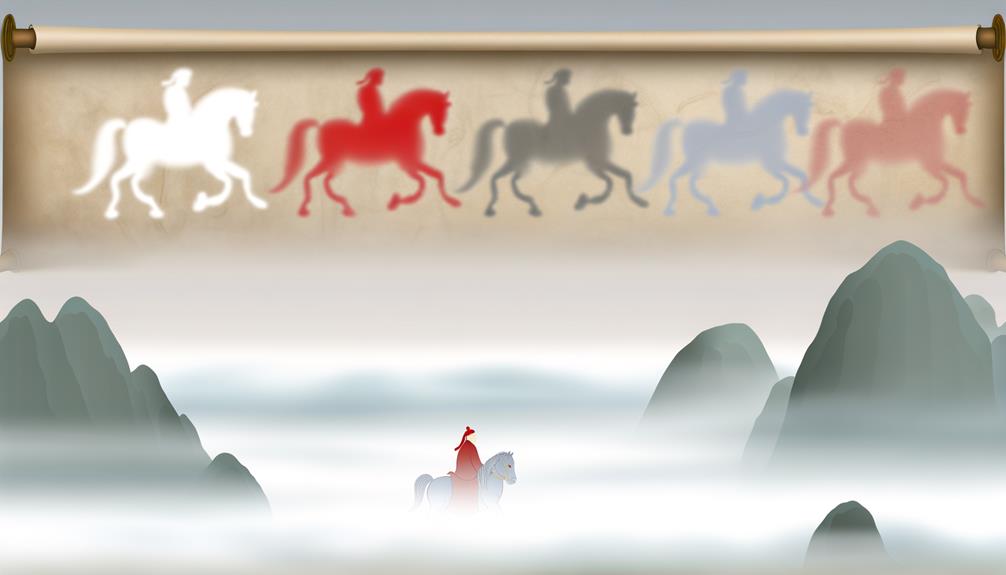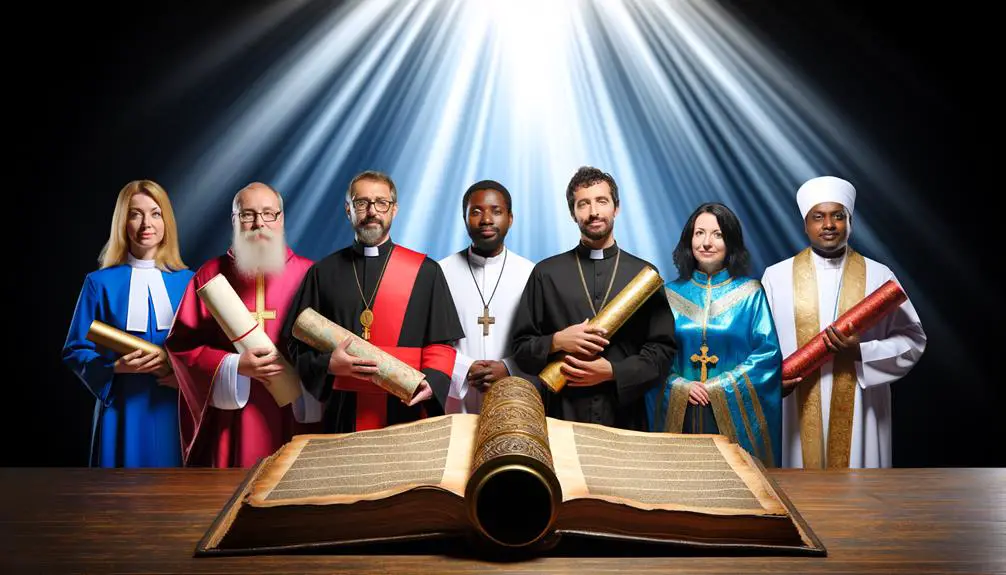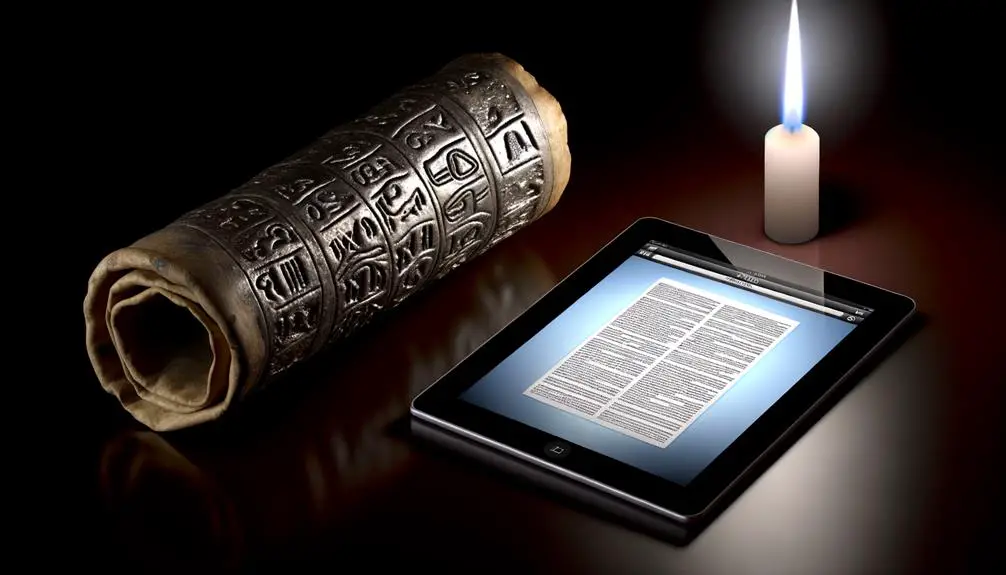Learn about the mysterious rider on the white horse in Revelation's first seal and uncover the secrets behind his allegorical conquest.

First Seal in the Bible
In the Book of Revelation, you'll encounter the first seal, featuring a conqueror on a white horse. This imagery, emblematic of deceptive conquest, emerges under the challenging shadow of late first-century Roman dominance and Christian persecution. The rider, cloaked in allegory, provokes scholarly debate—is he Christ, the Antichrist, or a figure of righteous or malignant conquest? Consensus varies, with interpretations shaped greatly by denominational lenses, ranging from divine sovereignty to prophetic deceit. This seal not only symbolizes the onset of eschatological events but also reflects a complex interplay of resistance and compliance in a persecuted society. Exploring further can uncover deeper insights into this paradoxical icon.
Key Takeaways
- The First Seal introduces a rider on a white horse, symbolizing conquest and potentially deceit.
- This figure carries a bow and is given a crown, signifying authority and victory.
- Interpretations vary: some see the rider as Christ or the Gospel, others as the Antichrist or false peace.
- The opening of the First Seal marks the beginning of the apocalyptic events described in Revelation.
- This seal's symbolism has sparked scholarly debates on its implications for Christian eschatology and moral reflection.
Historical Context of Revelation
The Book of Revelation's historical context is deeply rooted in the tumultuous period of late first-century Roman rule, when Christian persecution was intensifying. You'll find that understanding this era is vital to comprehending the text's urgency and cryptic nature. Revelation is a prime example of apocalyptic literature, a genre characterized by symbolic, often visionary storytelling intended to reveal hidden truths about God's ultimate plan. This genre thrived during periods of oppression, serving as a form of resistance literature that assured the faithful of divine justice.
Authorship debates further complicate the interpretation of Revelation. Traditionally attributed to John the Apostle, there's considerable scholarly contention surrounding this claim. Differences in language and style from the Gospel of John have led some experts to posit that a different John, perhaps John of Patmos, penned Revelation. This debate isn't just academic pedantry; it influences how you interpret the text's intended message and audience.
Your grasp on these elements—apocalyptic characteristics and the murky waters of authorship—will enrich your understanding of the text's function as both a product of its time and a timeless reflection on adversity and hope.
Symbolism of the First Seal
In analyzing Revelation's first seal, you'll notice it symbolically introduces a conqueror riding a white horse, emblematic of both conquest and deceit. This vivid imagery not only provides a striking visual but also holds deep allegorical meanings. The rider's identity remains a topic of extensive scholarly debate, yet it is widely regarded as either a divine or antichrist figure, both of which dramatically influence interpretations of the text.
The white horse, traditionally a symbol of purity and victory in ancient cultures, here paradoxically combines notions of noble conquest with underlying themes of deception. This duality invites you to ponder the complexities of the rider's mission, which at first seems righteous but may carry hidden intentions. The horse's color amplifies this tension, suggesting a facade of benevolence that masks more sinister undertones.
Moreover, the bow carried by the rider, devoid of arrows in the biblical description, adds another layer to the conquest symbolism. It represents power and intent without immediate violence, hinting at a conquest that is strategic and psychological, rather than solely physical. This aspect of the rider's armament underscores the sophisticated and multifaceted nature of the conquest depicted, pushing you to delve beyond the surface of martial triumph.
Interpretations Across Denominations

Across various Christian denominations, you'll find differing interpretations of the first seal, each influenced by distinct theological frameworks and historical contexts. In Catholicism, the first seal's rider on a white horse is often viewed symbolically as Christ or the spread of the Gospel. This interpretation aligns with a more triumphalist view of church history and eschatology, emphasizing victory and sovereignty.
Conversely, many Protestant denominations, particularly within evangelical and fundamentalist circles, interpret the rider as a figure of deception or even the Antichrist. This perspective reflects a more skeptical view of worldly powers and often correlates with a premillennialist understanding of the end times, where Christ's return is preceded by tribulation.
Denominational perspectives vary further in Orthodox Christianity, which sometimes interprets the first seal as the righteous conquest of spiritual truth over falsehood, a theme deeply embedded in its liturgical and theological tradition.
Ecumenical interpretations attempt to bridge these diverse views, focusing on shared themes such as divine sovereignty and the ultimate triumph of good over evil. These cross-denominational discussions can enrich the understanding of Revelation's complex symbolism by highlighting the universal aspects of Christian hope and the prophetic call to faithfulness amidst trials.
Impact on Christian Eschatology
Understanding the first seal's impact on Christian eschatology reveals how deeply it shapes believers' expectations of the end times. The revealing of this seal, as described in the Book of Revelation, plays a pivotal role in setting the stage for subsequent events that are believed to unfold during the apocalypse. The imagery of the conquering white horse and its rider, often interpreted as a symbol of Christ or the Antichrist, introduces a period of divine timing—where each seal's revelation corresponds to specific, prophesied happenings.
This notion of divine timing is integral to apocalyptic anticipation. It suggests that every event, including wars, famines, and other tribulations linked to the seals, occurs at a preordained moment, reinforcing the idea that history is moving inexorably towards a divinely orchestrated climax. For you as a believer, this can be both reassuring and challenging. It implies that while earthly struggles may seem chaotic, they are part of a larger, divine plan that is ultimately benevolent.
Moreover, this perspective influences how you perceive current global events. Every major crisis is often scrutinized through the lens of these prophetic markers, with many believers seeing them as signs of the approaching end times, thereby intensifying their spiritual vigilance and interpretative efforts. This framework not only offers a narrative of hope and redemption but also a call to moral readiness as the final days draw near.
Modern Relevance and Reflections

Reflecting on how the first seal's interpretation affects contemporary faith practices shows its ongoing significance in shaping spiritual perspectives. The allegorical layers you uncover in the imagery of conquest and sovereignty resonate deeply with personal growth and societal ethics today. This seal isn't just a historical or prophetic marker; it's a mirror reflecting the perennial spiritual battles and victories within and around you.
Delving deeper, the first seal's implications on personal growth are profound. It's about conquering inner demons and emerging victorious in the pursuit of spiritual enlightenment and moral integrity. For you, this might mean a continuous re-evaluation of your values and actions in light of ever-evolving spiritual insights. It prompts a question: how do your personal beliefs align with your actions in the world?
Moreover, the societal ethics dimension of the first seal challenges you to ponder how collective morality is shaped by prevailing spiritual narratives. It pushes communities to reflect on their moral compass, especially in times of crisis or moral ambiguity. How does your community interpret justice, power, and leadership? This reflection isn't merely academic—it's crucial for nurturing a society that holds itself accountable to higher ethical standards, ensuring that spiritual growth isn't confined to individual endeavors but is a collective evolution.
Frequently Asked Questions
Who Was the Author of the Book of Revelation?
You're diving into a centuries-old mystery! The authorship of Revelation, steeped in debates, hinges on visionary identity. Traditionally, John the Apostle is credited, though scholars meticulously analyze stylistic differences to challenge this view.
How Many Seals Are Mentioned in the Book of Revelation?
In the Book of Revelation, seven seals are mentioned, each vital to understanding prophetic timelines and seal interpretations. You'll find these play a pivotal role in unfolding the eschatological narrative detailed therein.
What Does the White Horse Symbolize in Other Religious Texts?
In other religious texts, the white horse often symbolizes purity and victory. In Hindu symbolism, it's associated with the sun god, Surya, while Buddhist interpretations link it to overcoming obstacles and spiritual progress.
Are There Any Archaeological Findings Related to the First Seal?
Ironically, despite extensive searches, you'll find no specific archaeological findings directly linked to seal interpretations in a historical context that clarify their origins or purpose related to the topic you're inquiring about.
How Has Popular Culture Portrayed the First Seal?
In popular culture, you've likely seen apocalyptic films that interpret the First Seal, often depicting cataclysmic events signaling world-altering changes, a theme grounded in deep, symbolic analysis of prophetic and eschatological literature.



Sign up